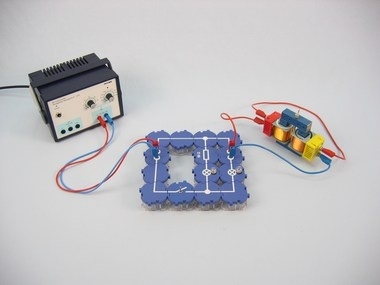Principle
The students know that self-induced voltage is generated in a coil in a direct current circuit when the circuit is closed or opened. They also know which direction the sel-finduced current has.
Based on this knowledge, they can probably predict what happens when alternating current flows through a coil. The first experiment demonstrates that the additional resistance, which coils possess in an alternating current circuit as opposed to their resistance in a direct current circuit, is dependent on frequency. Of course, there is no alternating voltage source used to provide a variable frequency in this experiment, but a similar effect can be achieved by switching the switch for direct voltage on and off at different rates.
The second experiment is used to provide a semi-quantitative analysis of the dependency of inductive resistance on the number of turns and the coil core.
Benefits
- No additional cable connections between the building blocks needed - clear arragned and quick setup
- Contact saftey due to puzzle blocks system
- Corrosion-free gold plated contacts
- Doubled earning sucess: Electric circuit diagram on top, real components can be seen unterside
Tasks
How does a coil act in an alternating current circuit?
Prove that a coil in an alternating current circuit possesses a resistance in addition to the ohmic resistance from its wound wire and investigate the factors responsible for this additional resistance.


